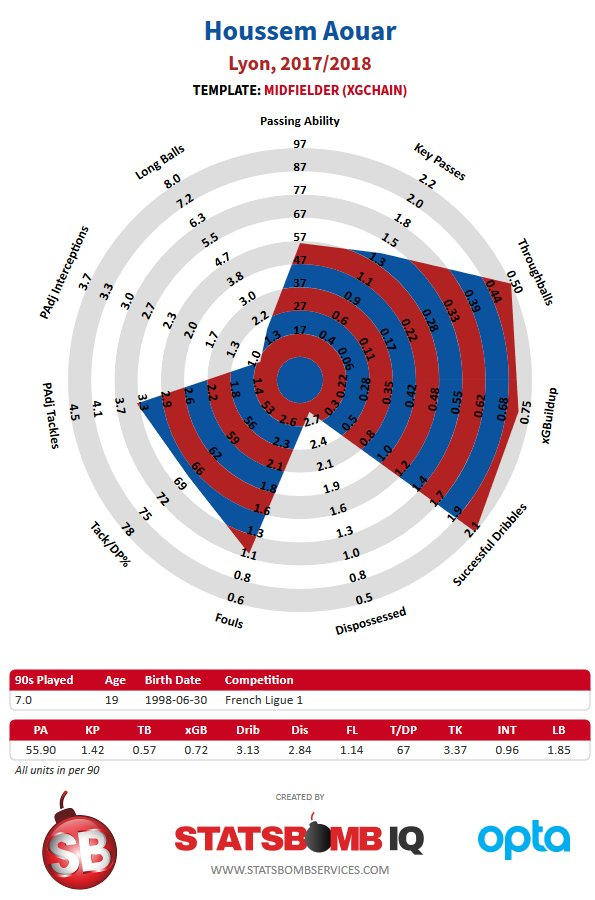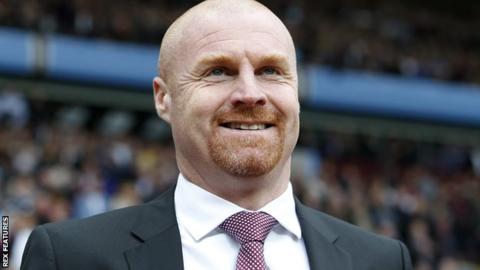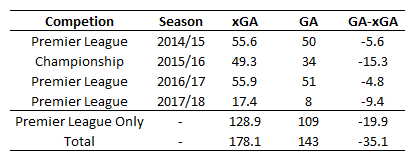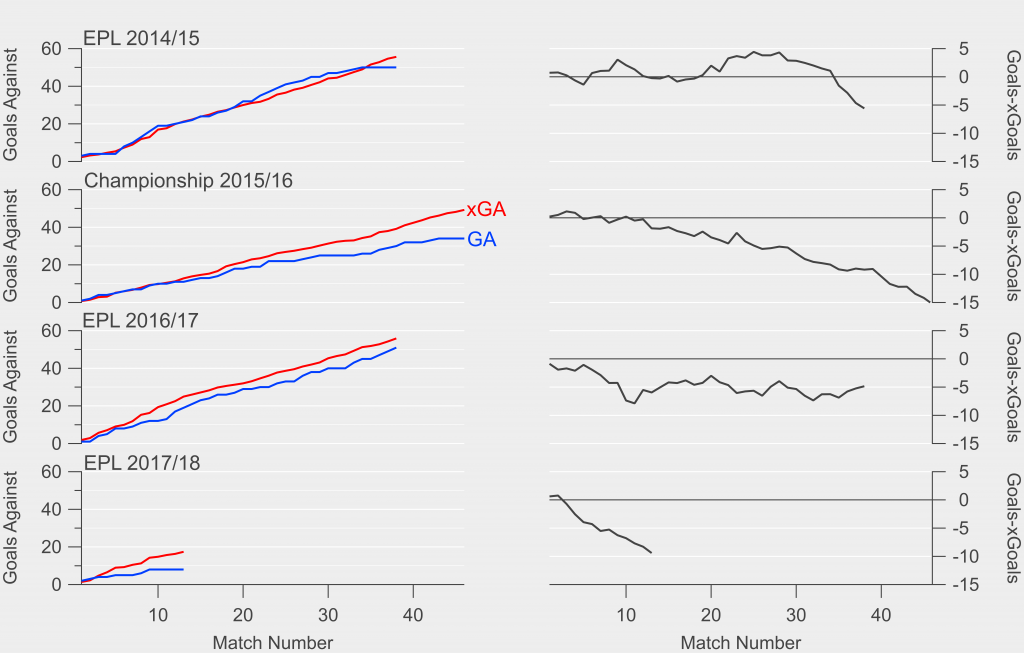Florian Thauvin has been a hot topic within French football for years. From his initial start at Bastia where he helped the club stave off relegation, to his controversial move away from Lille to Marseille, to being derided and held as an example of flawed transfer policy when he moved to Newcastle in the summer of 2015. He was once seen as the heir apparent to Franck Ribery, the type of winger who could have a whole team be built around him yet was also ridiculed by Alan Shearer on Match of the Day for wearing a tuxedo to Newcastle games. He almost became a lost figure, a once highly touted prospect left behind as a newer generation of French wonderkids like Anthony Martial, Ousmane Dembele and Kylian Mbappe made their mark. Marseille are 4th in Ligue 1 right now, which is about where you would might expect them to be considering the talent at their disposal. What’s really been interesting is the pure shot volume that they’ve been operating on, and to a lesser extent the league as a whole. Compared to the rest of the Big 5 Leagues, Ligue 1 doesn’t usually have as many shots in their games because of the slower pace. Teams as a whole have also gotten smarter during the Opta era when it comes to prioritizing shot location, and not just dithering about the pitch and launching 20+ yard shots on a consistent basis. Or at least they had: so it makes what’s happening in Ligue 1 this season all the more interesting with shot volume up across the board, and lots from range. 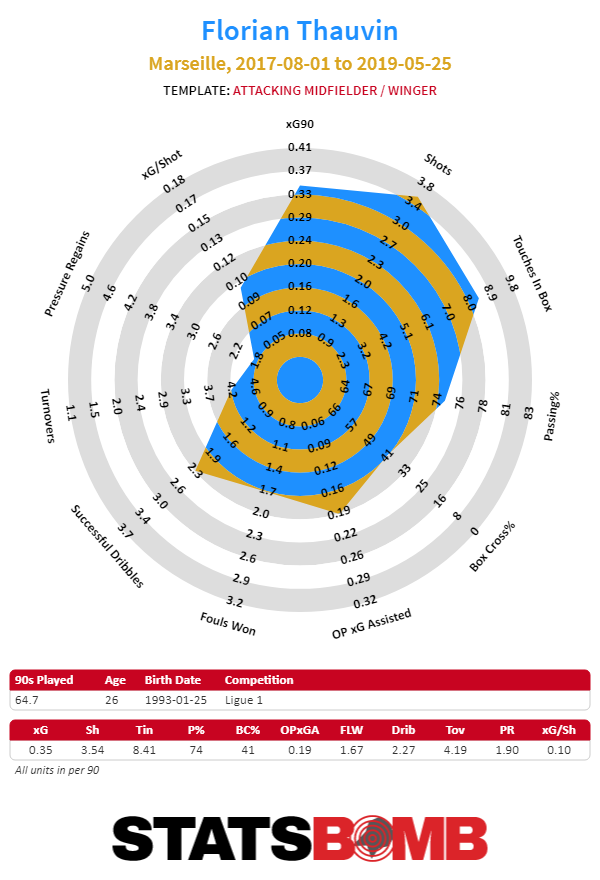 Why that’s the case, I’m not entirely sure. It could also be that this season, Ligue 1 is almost the junior version of the PL where there’s a core four (PSG, Monaco, Lyon, Marseille), and then there’s everyone else fighting for scraps. Certainly, the fact that Ligue 1 has two extreme outliers within that core four is helping as well. Both PSG and Marseille rank in the top 12 within the big five in Europe when it comes to shots per game and shots inside the box. Half of this at least passes the smell test. You could’ve imagined PSG leaving a trail of destruction in their wake, as they’re as close to the Monstars as Ligue 1 has seen in the modern era. https://www.youtube.com/watch?v=IDna-qlJ5pg In terms of recent history, we have never seen two teams shoot more times in Ligue 1.
Why that’s the case, I’m not entirely sure. It could also be that this season, Ligue 1 is almost the junior version of the PL where there’s a core four (PSG, Monaco, Lyon, Marseille), and then there’s everyone else fighting for scraps. Certainly, the fact that Ligue 1 has two extreme outliers within that core four is helping as well. Both PSG and Marseille rank in the top 12 within the big five in Europe when it comes to shots per game and shots inside the box. Half of this at least passes the smell test. You could’ve imagined PSG leaving a trail of destruction in their wake, as they’re as close to the Monstars as Ligue 1 has seen in the modern era. https://www.youtube.com/watch?v=IDna-qlJ5pg In terms of recent history, we have never seen two teams shoot more times in Ligue 1.
| Year | Team | Shots per game |
| 2017-18 | PSG | 17.4 |
| 2017-18 | Marseille | 16.6 |
| 2013-14 | PSG | 15.7 |
| 2011-12 | Montpellier | 15.7 |
| 2009-10 | Marseille | 15.7 |
At the head of this for Marseille has been Thauvin, who’s having by far the best season of his career. The untapped potential that many had seen in him has come full bloom over the 1606 minutes he’s played this season. Out of all player in Ligue 1 to have played at least 450 minutes, Thauvin is in the top 10 in non-penalty goals + assists per 90, and in the top five in expected goal contribution per 90 minutes. He’s been the best player on arguably the 2nd best team in Ligue 1. Never has he been given as much responsibility in attack as he has this season, and he’s responded as well as one could've hoped for. 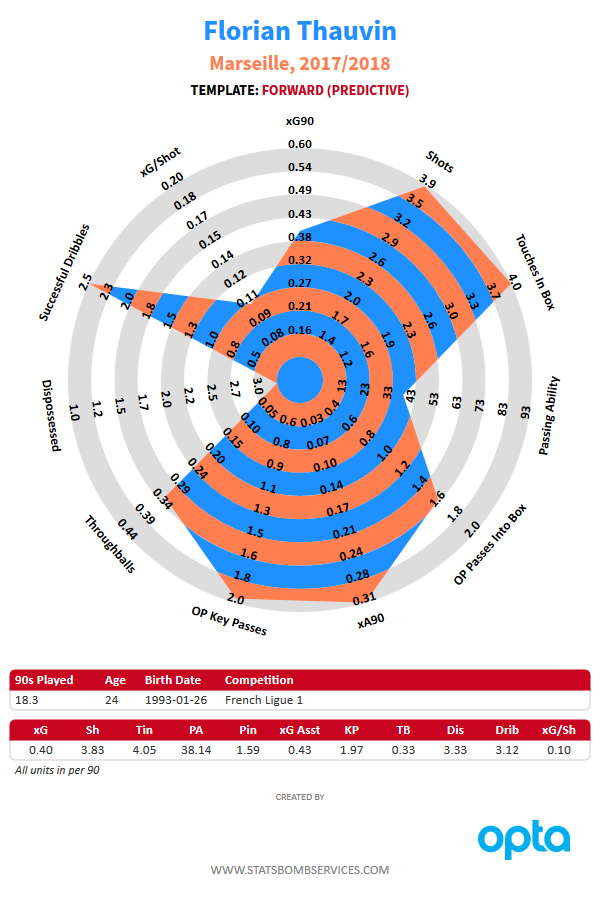 There’s such a fluidity and flexibility within Marseille’s set up whenever they’re in possession. On the most basic level, what Marseille try to do is offer passing outlets in tight spaces, forming different types of shapes on the pitch where they are progressing the ball from one zone to another. At times, they’ll try and shrink the pitch so as whenever they try and switch the play from one side to another, it could lead to a dangerous opportunity. In a sense, there’s little bits here and there where it’s reminiscent of the Bielsa led 2014-15 side. It’s a deliberate, methodical style of play looking for the first crack in place and immediately pouncing on it based on the caliber of attacking players and passers on the team.
There’s such a fluidity and flexibility within Marseille’s set up whenever they’re in possession. On the most basic level, what Marseille try to do is offer passing outlets in tight spaces, forming different types of shapes on the pitch where they are progressing the ball from one zone to another. At times, they’ll try and shrink the pitch so as whenever they try and switch the play from one side to another, it could lead to a dangerous opportunity. In a sense, there’s little bits here and there where it’s reminiscent of the Bielsa led 2014-15 side. It’s a deliberate, methodical style of play looking for the first crack in place and immediately pouncing on it based on the caliber of attacking players and passers on the team. 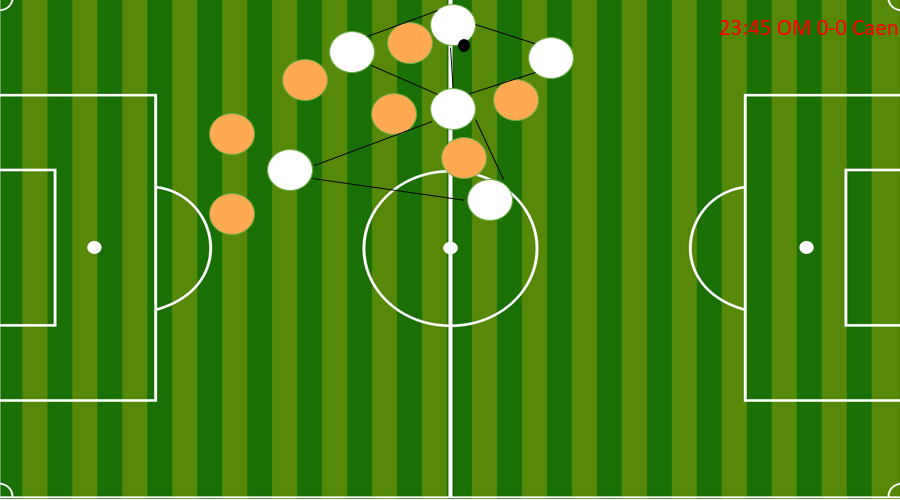
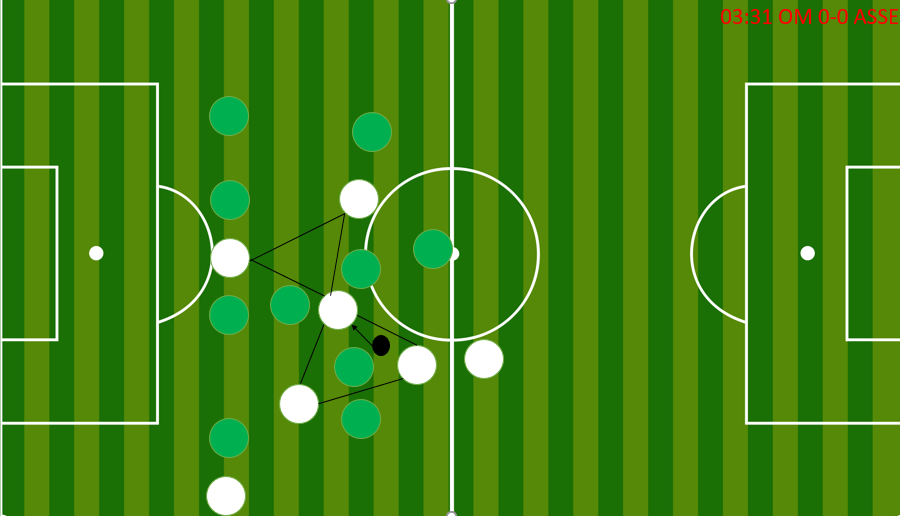 With the likes of Jordan Amavi, Bouna Sarr, and Hiroki Sakai, there will always be the corresponding width needed for the attacking midfielders to drift inside and play in the half space. This could be manipulated into third man/blindside runs where the full backs take advantage of the attention towards the midfielders in the half space, and they have acres of field to run into and potentially find something advantageous. https://streamable.com/em4qc Seeing the intricacy that has been displayed makes it a teeny bit more understandable as to why Marseille skewed older with their transfer recruitment over the past 2-3 windows. The failed experiment at Lille has shown that it can be very hard teaching a young squad to implement this sort of structure. What Marseille did still does carry the very real downside risk of having lots of older players with years left on their contracts on wages that won’t be easy to shed, but at least they’ve gotten close to the best-case "win now" scenario where everything is clicking, and the older players still have some gas in the tank. What’s helped Thauvin this season is that there’s a clear preference as to how Marseille attack with the ball. Marseille are a right sided dominant team with their attacks, which means Thauvin sees a lot of the ball. His position varies depending on whether the ball is played long or short by the keeper or defense. If the ball is being circulated out of the back, Thauvin will tend to stick somewhat closer to the sidelines. The goal of this is having someone as technically proficient as him as one of the passing options within the shape that’s being constructed to progress the ball forward. However, sometimes he'll drift into the middle of the park to help switch the play when there's an opening. https://streamable.com/ms5rr His ability to work in tight areas means he is hard to knock off the ball during passing sequences. When the ball is recycled back from the middle or attacking third back to the defense. Thauvin will usually stay closer to the middle of the pitch while the full backs take full ownership of the wing area, kind of lurking around to see if there’s space to run into so he can play a final ball. There will also be times where nothing is going on in terms of support and Thauvin takes the ball from around the midfield area and gets it to the final third by dribbling. He’s not exactly someone who has the athleticism to blow by past everyone for 60+ yards, but again he excels at getting past opponents in tight areas and having that mini burst. https://streamable.com/p7qoz When the ball enters the final third, Thauvin’s role is very much similar to a lot of inverted wingers. When he does decide to shoot, most of his shots come from the right channel in the penalty area and right half of the danger zone. His shot selection isn’t perfect, he is still prone to take his fair share of bad shots from the perimeter. Some of them are excusable because there weren’t other viable options outside taking a 3-4% shot, but compared to the likes of Memphis Depay or Keita Balde, he does have worse shot selection on average. https://streamable.com/sf4dp When he makes a pass into the penalty area, one thing he’ll do is briskly jog into the area to present himself as a threat if he does get a pass back from the original target and shoot himself. Sometimes the spacing can be a little weird when it happens but it does represent another option. https://streamable.com/yiplu Marseille isn’t a hugely fast team, but against a defense that isn’t set, they can get men forward and get opportunities because their attackers have mobility and can viably occupy different spots on the pitch as threats (especially when Germain is playing as the forward). When given the ball to run and with a non-settled defense, Thauvin is a dual threat as both a creator and a shot taker. This is probably the part of his game that has most improved over the past few years and can make smart choices. When he does pass it, he generally likes to aim it on the right half of the penalty box and trusts his teammates will get on the end of it. https://streamable.com/7k2zs There will be those who’ll look at Thauvin’s success and say something to the tune of “well of course he’s doing better in the Ligue 1, it’s a weaker league compared to the Premier League”. This kind of analysis is very basic, and ignores the number of successes that have come with paying for young French talents over the past few years, but it is true that Thauvin’s time at Newcastle was an unmitigated disaster. But we can at least give educated guesses as to why his time in the Premier League was dreadful:
With the likes of Jordan Amavi, Bouna Sarr, and Hiroki Sakai, there will always be the corresponding width needed for the attacking midfielders to drift inside and play in the half space. This could be manipulated into third man/blindside runs where the full backs take advantage of the attention towards the midfielders in the half space, and they have acres of field to run into and potentially find something advantageous. https://streamable.com/em4qc Seeing the intricacy that has been displayed makes it a teeny bit more understandable as to why Marseille skewed older with their transfer recruitment over the past 2-3 windows. The failed experiment at Lille has shown that it can be very hard teaching a young squad to implement this sort of structure. What Marseille did still does carry the very real downside risk of having lots of older players with years left on their contracts on wages that won’t be easy to shed, but at least they’ve gotten close to the best-case "win now" scenario where everything is clicking, and the older players still have some gas in the tank. What’s helped Thauvin this season is that there’s a clear preference as to how Marseille attack with the ball. Marseille are a right sided dominant team with their attacks, which means Thauvin sees a lot of the ball. His position varies depending on whether the ball is played long or short by the keeper or defense. If the ball is being circulated out of the back, Thauvin will tend to stick somewhat closer to the sidelines. The goal of this is having someone as technically proficient as him as one of the passing options within the shape that’s being constructed to progress the ball forward. However, sometimes he'll drift into the middle of the park to help switch the play when there's an opening. https://streamable.com/ms5rr His ability to work in tight areas means he is hard to knock off the ball during passing sequences. When the ball is recycled back from the middle or attacking third back to the defense. Thauvin will usually stay closer to the middle of the pitch while the full backs take full ownership of the wing area, kind of lurking around to see if there’s space to run into so he can play a final ball. There will also be times where nothing is going on in terms of support and Thauvin takes the ball from around the midfield area and gets it to the final third by dribbling. He’s not exactly someone who has the athleticism to blow by past everyone for 60+ yards, but again he excels at getting past opponents in tight areas and having that mini burst. https://streamable.com/p7qoz When the ball enters the final third, Thauvin’s role is very much similar to a lot of inverted wingers. When he does decide to shoot, most of his shots come from the right channel in the penalty area and right half of the danger zone. His shot selection isn’t perfect, he is still prone to take his fair share of bad shots from the perimeter. Some of them are excusable because there weren’t other viable options outside taking a 3-4% shot, but compared to the likes of Memphis Depay or Keita Balde, he does have worse shot selection on average. https://streamable.com/sf4dp When he makes a pass into the penalty area, one thing he’ll do is briskly jog into the area to present himself as a threat if he does get a pass back from the original target and shoot himself. Sometimes the spacing can be a little weird when it happens but it does represent another option. https://streamable.com/yiplu Marseille isn’t a hugely fast team, but against a defense that isn’t set, they can get men forward and get opportunities because their attackers have mobility and can viably occupy different spots on the pitch as threats (especially when Germain is playing as the forward). When given the ball to run and with a non-settled defense, Thauvin is a dual threat as both a creator and a shot taker. This is probably the part of his game that has most improved over the past few years and can make smart choices. When he does pass it, he generally likes to aim it on the right half of the penalty box and trusts his teammates will get on the end of it. https://streamable.com/7k2zs There will be those who’ll look at Thauvin’s success and say something to the tune of “well of course he’s doing better in the Ligue 1, it’s a weaker league compared to the Premier League”. This kind of analysis is very basic, and ignores the number of successes that have come with paying for young French talents over the past few years, but it is true that Thauvin’s time at Newcastle was an unmitigated disaster. But we can at least give educated guesses as to why his time in the Premier League was dreadful:
- He went from Ligue 1 at age 22 after not exactly setting the world on fire in his previous season at Marseille. Considering that the team in question was a relegation candidate like Newcastle + a different financial environment, paying ~£15M was a risky proposition.
- The criticism of him not tracking back defensively wasn’t entirely off base, and Thauvin wasn’t nearly good enough in attack to make up for it.
- He played very few minutes, 182 of them as a sub and only started 3 of his 13 games.
- He went to Newcastle, who were coached by Steve McLaren. That's challenging for anyone, let alone a young French kid in his first big move.
Assuming his form continues until the end of the season, there’s a good chance that some team in Europe would try and get him over the summer. Thauvin has reportedly been lined up by the likes of Bayern Munich and Atletico Madrid for a move away from the Stade Veledrome. There’s no guarantee that moving again from Marseille will work out any better, and he very well might be a player who can only thrive in Ligue 1, but we do have a grander sample size of what he is compared to 2015. He probably rated as a top 15 attacking player in Ligue 1 last season, and on current form, he’s been the best non-PSG attacker in the league. He’s been a genuinely good player who, at least for this season, has made the leap to great. Florian Thauvin is proof of just how hard it can be to forecast player development and how wildly it can vary before a player delivers on early promise. He’s gone from a prodigy to mercurial talent to bust to salvation in a short space of time and he’s still just 24 years old. These should be his best years. In some ways, his career has mirrored someone like Adnan Januzaj, with both players taking the road less travelled to before looking like finally realizing their potential as a player. At the rate he is going, he’s certainly in contention for the spot in the French National side heading into the 2018 World Cup. It’s been a wild ride, but it could end up with him leading Marseille to their first appearance back in the Champions League since 2013-14.
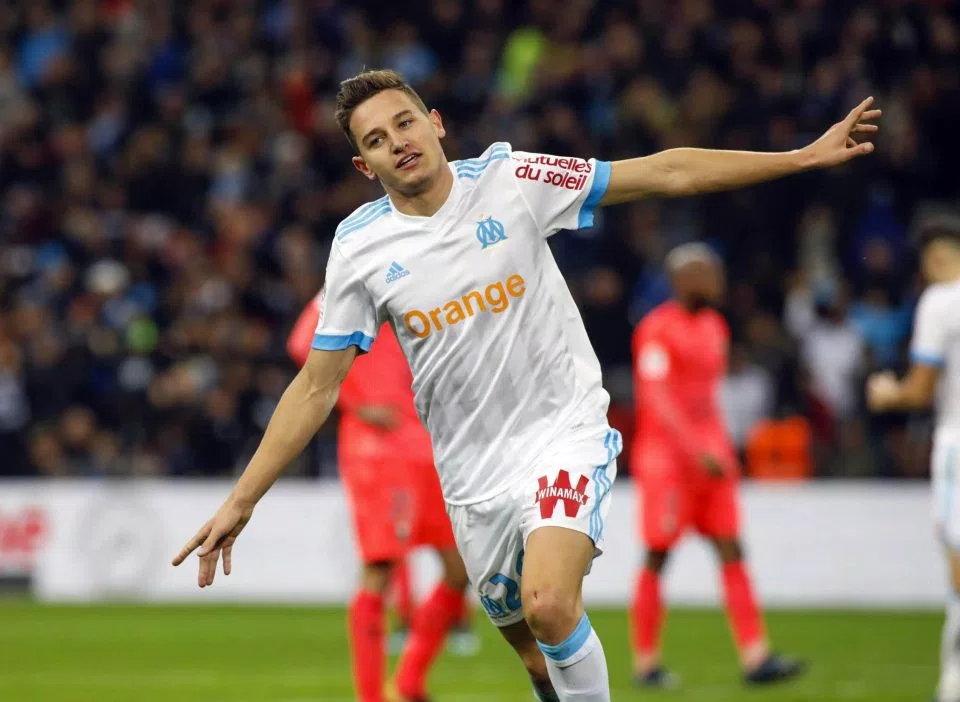
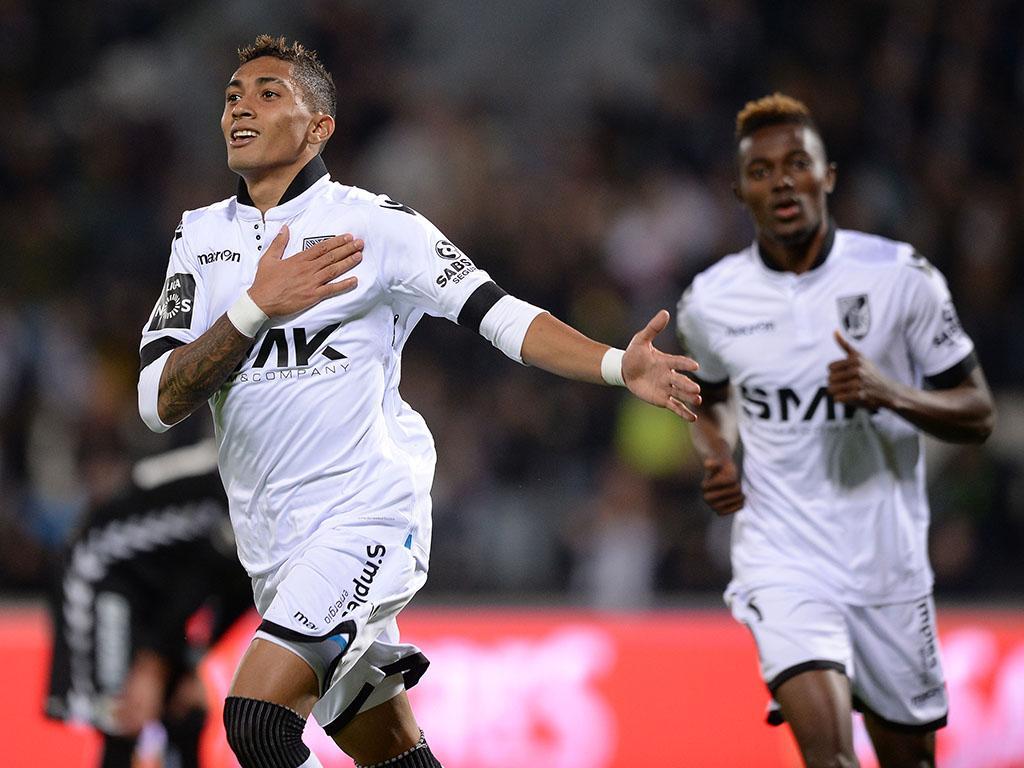
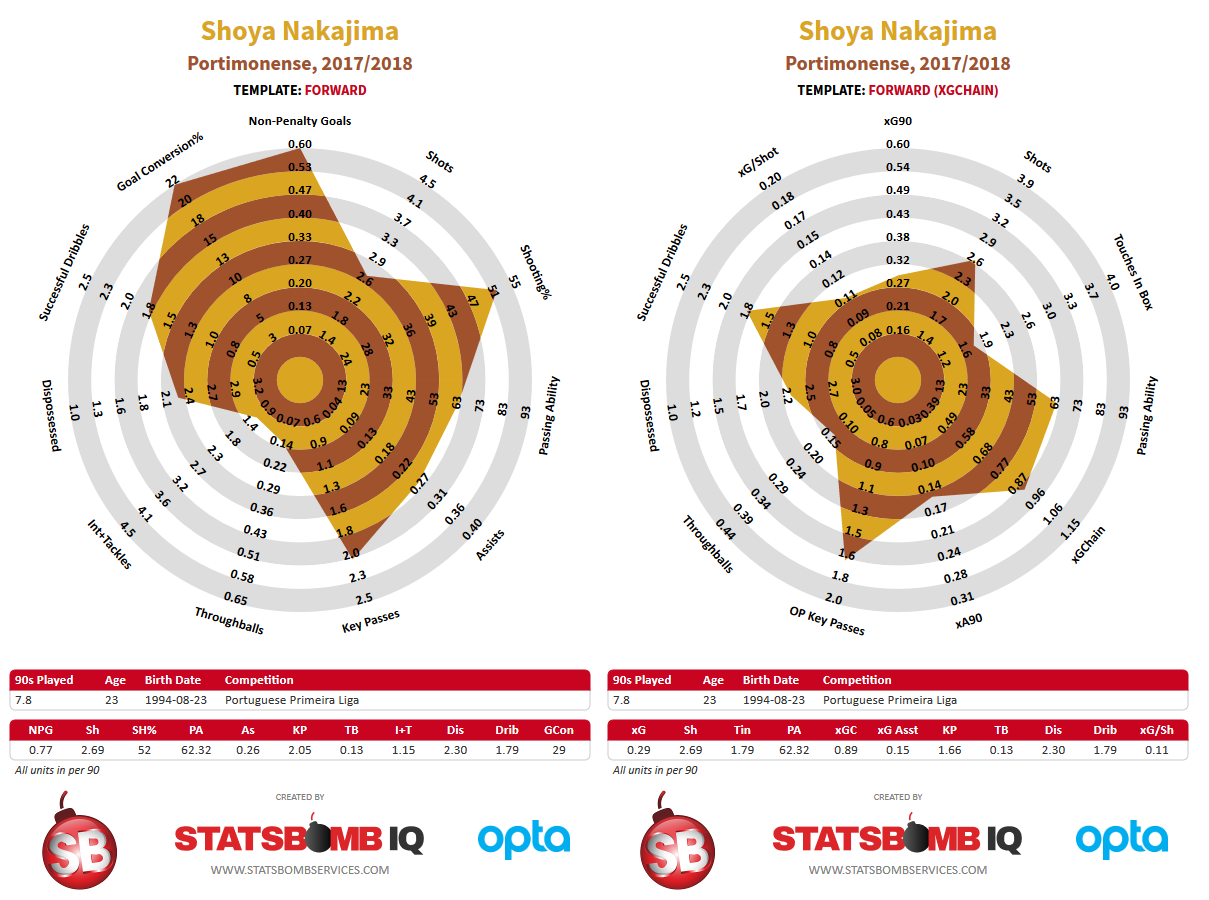 If you look at his initial numbers he looks straight up insane, that he's highly rated makes sense and just being generally fun to watch. Playing as a wide forward from the left, he’s already scored 6 goals and sprinkled a couple of assists on top. He won his spot with the season already under way, that’s why he has played only ~700’ – and means we should be cautious in our interpretation. If we look at his xG Chain Template, it’s not surprising to see his numbers drop when looked at through xG glasses since he scored his six goals from only 21 shots and he takes a large portion of them from outside the box (~62%). That said, 0.29 xG/90 is still very decent for a wide forward, and five of his goals have come from inside the box so… I think he gets the concept. Beyond that, he is actually quite the complete creator, with above average dribbling and key pass numbers. A clever little footballer, his capacity to pierce through tight spaces from his low centre of gravity with the ball always under control should be highlighted. Any potential progression to a bigger team should be aided by that capacity to work against closed defences. Well, by that and by the fact that his team doesn’t really play like a small side in a traditional sense – Portimonense have the 4th highest goal tally in the league despite just being promoted (they also concede the 2nd most in the league so yes, they’re a very fun watch). Portimonense’s largest ever sale: Simy to Crotone (16/17) – 830k € Next up is Vitória SC’s Raphinha. Last season Vitória had their best season in years, finishing in fourth with an eight point margin to rivals Braga who had to settle for fifth. Raphinha was in his first season with the main team and his influence grew as the season went on, taking advantage of teammates’ injuries to get minutes and finishing the season with 10 G+A in ~1700’. With player turnover in the summer, he became the team’s number one option out wide at just 20 years old. He is the league’s fourth top scorer with eight goals already, is playing in the Europa League and is deemed the star man for his side. He is bound to show up on radar of a lot of clubs but the question is, is he worth pursuing?
If you look at his initial numbers he looks straight up insane, that he's highly rated makes sense and just being generally fun to watch. Playing as a wide forward from the left, he’s already scored 6 goals and sprinkled a couple of assists on top. He won his spot with the season already under way, that’s why he has played only ~700’ – and means we should be cautious in our interpretation. If we look at his xG Chain Template, it’s not surprising to see his numbers drop when looked at through xG glasses since he scored his six goals from only 21 shots and he takes a large portion of them from outside the box (~62%). That said, 0.29 xG/90 is still very decent for a wide forward, and five of his goals have come from inside the box so… I think he gets the concept. Beyond that, he is actually quite the complete creator, with above average dribbling and key pass numbers. A clever little footballer, his capacity to pierce through tight spaces from his low centre of gravity with the ball always under control should be highlighted. Any potential progression to a bigger team should be aided by that capacity to work against closed defences. Well, by that and by the fact that his team doesn’t really play like a small side in a traditional sense – Portimonense have the 4th highest goal tally in the league despite just being promoted (they also concede the 2nd most in the league so yes, they’re a very fun watch). Portimonense’s largest ever sale: Simy to Crotone (16/17) – 830k € Next up is Vitória SC’s Raphinha. Last season Vitória had their best season in years, finishing in fourth with an eight point margin to rivals Braga who had to settle for fifth. Raphinha was in his first season with the main team and his influence grew as the season went on, taking advantage of teammates’ injuries to get minutes and finishing the season with 10 G+A in ~1700’. With player turnover in the summer, he became the team’s number one option out wide at just 20 years old. He is the league’s fourth top scorer with eight goals already, is playing in the Europa League and is deemed the star man for his side. He is bound to show up on radar of a lot of clubs but the question is, is he worth pursuing? 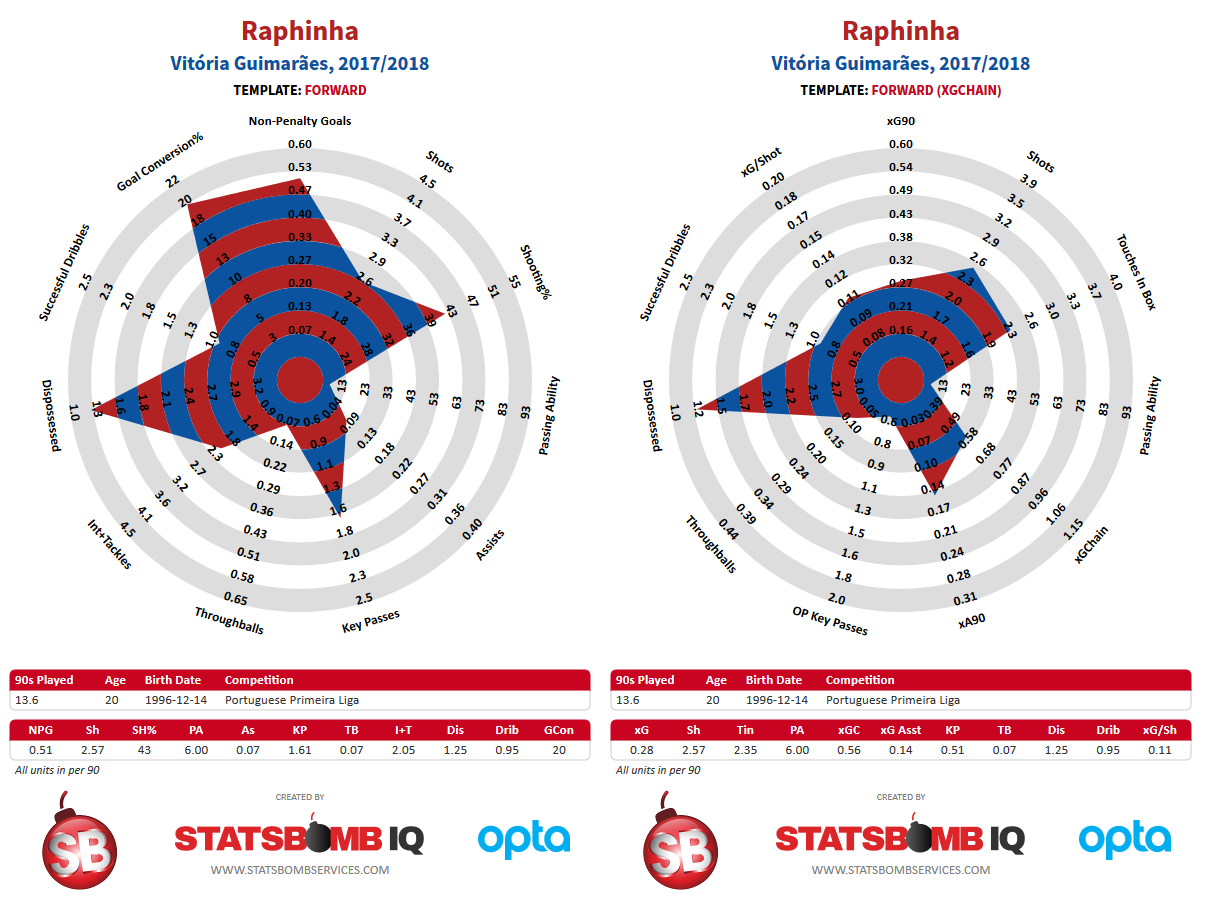 Well, he is obviously overperforming when it comes to goals, but he is still putting up decent xG figures for a winger – reminder that this is a forward template and except if you’re called Mo Salah, you’re not really expected to be putting up 0.5 XG/90 from wide. Left footed playing from the right, he tends to appear well in the box where he takes a solid majority of his shots. Creation wise, he relies a lot on set-pieces to back up his key passing numbers but, on the other hand, is a good set-piece taker. For a player who is as technically able as he is, he doesn’t complete nor try as large of an amount of take-ons as one might expect, but it comes down to the set-up more than the individual ability. Vitória SC are very counter-attack reliant offensively, so his role is direct and heavily focused on exploiting his speed into open space and the timing of his runs into the box. I’m a bit doubtful of his potential to grow into a player for a possession-based big team set-up but could very well work as a Mahrez-esque asset for a mid-table side. The Liga NOS-Serie A route is a bit uncommon but since Raphinha carries Italian nationality alongside his Brazilian one, I can see it happening. Vitória SC’s largest ever sale: Bebe to Manchester United (10/11) – 8.8M€ Finally, Oghenekaro Etebo. Although semi-unknown as well, Etebo is, out of these three, the player with most press behind him. He's been linked to Premier League teams multiple times over the last year (mainly Leicester but WBA and Arsenal as well) and, with his 13 senior caps, is a familiar face of this Nigeria side that qualified for the World Cup, so it’s pretty safe to assume he'll be in Russia. All very positive signs for a 22-year-old who is now only on his second full season with Feirense.
Well, he is obviously overperforming when it comes to goals, but he is still putting up decent xG figures for a winger – reminder that this is a forward template and except if you’re called Mo Salah, you’re not really expected to be putting up 0.5 XG/90 from wide. Left footed playing from the right, he tends to appear well in the box where he takes a solid majority of his shots. Creation wise, he relies a lot on set-pieces to back up his key passing numbers but, on the other hand, is a good set-piece taker. For a player who is as technically able as he is, he doesn’t complete nor try as large of an amount of take-ons as one might expect, but it comes down to the set-up more than the individual ability. Vitória SC are very counter-attack reliant offensively, so his role is direct and heavily focused on exploiting his speed into open space and the timing of his runs into the box. I’m a bit doubtful of his potential to grow into a player for a possession-based big team set-up but could very well work as a Mahrez-esque asset for a mid-table side. The Liga NOS-Serie A route is a bit uncommon but since Raphinha carries Italian nationality alongside his Brazilian one, I can see it happening. Vitória SC’s largest ever sale: Bebe to Manchester United (10/11) – 8.8M€ Finally, Oghenekaro Etebo. Although semi-unknown as well, Etebo is, out of these three, the player with most press behind him. He's been linked to Premier League teams multiple times over the last year (mainly Leicester but WBA and Arsenal as well) and, with his 13 senior caps, is a familiar face of this Nigeria side that qualified for the World Cup, so it’s pretty safe to assume he'll be in Russia. All very positive signs for a 22-year-old who is now only on his second full season with Feirense. 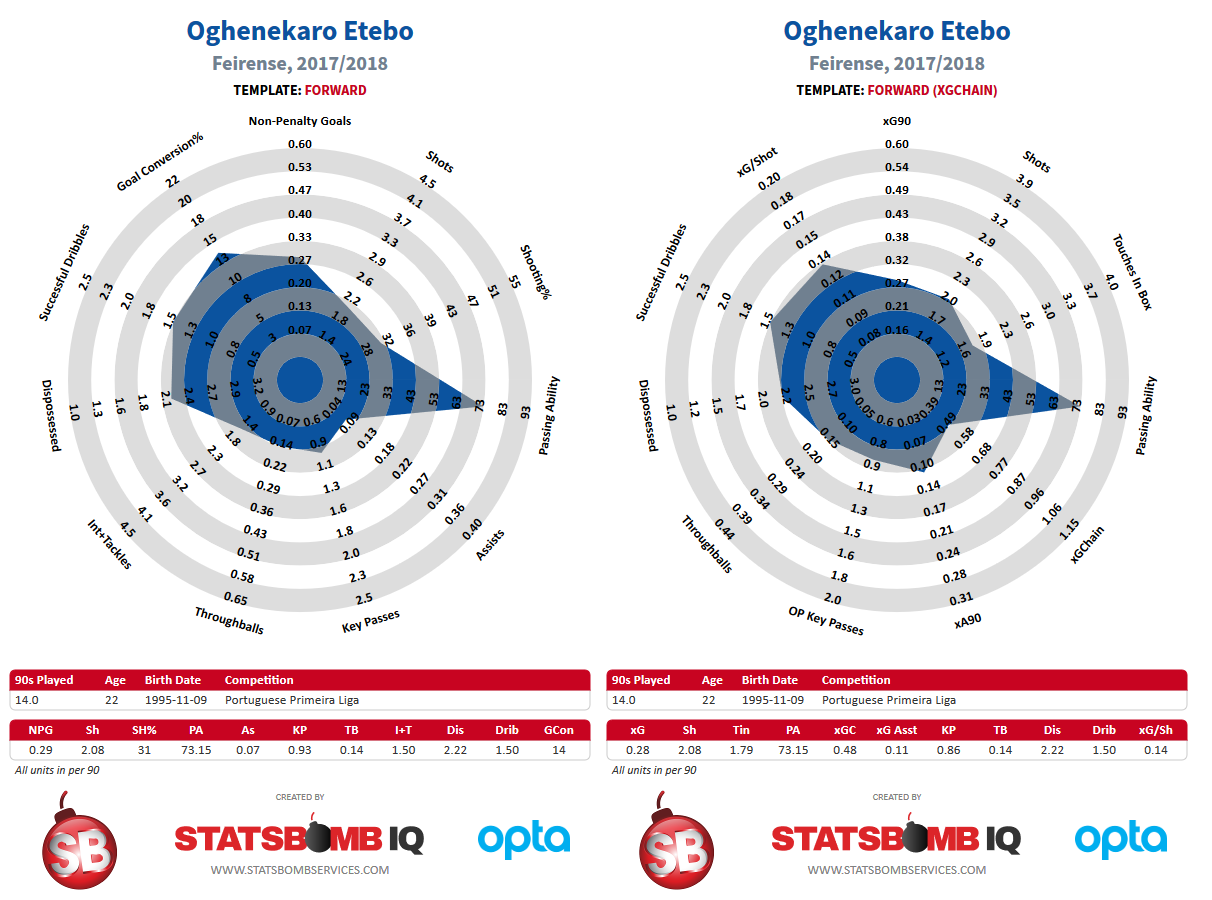 Let's start by saying his output isn't amazing, but it does match expectation and he is legitimately quite an interesting player. Often playing from the left in Feirense’s 4-2-3-1, he’s been deployed centrally a couple of times as well – either as a striker or as an attacking midfielder. In the national team, he has also been used in a central role with a lot of emphasis on late runs into the box. Back to the league, Feirense are in an awful run of form and are the third worst team at keeping possession of the ball. An even bigger issue is that they don’t play many long balls either (12th in the league). They want to keep the ball and play short with it, they’ve just been unable to. This means Etebo doesn’t get the ball anywhere near enough, is often positioned too deep to have much offensive impact so – on the other hand – gets more defensive action than most wide players. He is one of those players who I believe would look a lot better in a per-possession spectrum as opposed to per-90 minutes – something that has been discussed on Twitter a
Let's start by saying his output isn't amazing, but it does match expectation and he is legitimately quite an interesting player. Often playing from the left in Feirense’s 4-2-3-1, he’s been deployed centrally a couple of times as well – either as a striker or as an attacking midfielder. In the national team, he has also been used in a central role with a lot of emphasis on late runs into the box. Back to the league, Feirense are in an awful run of form and are the third worst team at keeping possession of the ball. An even bigger issue is that they don’t play many long balls either (12th in the league). They want to keep the ball and play short with it, they’ve just been unable to. This means Etebo doesn’t get the ball anywhere near enough, is often positioned too deep to have much offensive impact so – on the other hand – gets more defensive action than most wide players. He is one of those players who I believe would look a lot better in a per-possession spectrum as opposed to per-90 minutes – something that has been discussed on Twitter a 